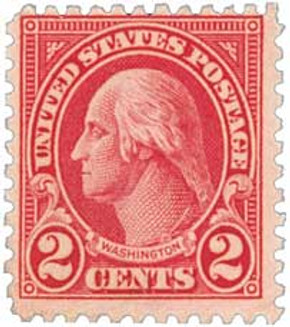
U.S. #645
1928 2¢ Valley Forge Issue
Issue Date: May 26, 1928
First City: Washington, DC and six cities
Issue Quantity: 101,330,328
Washington Winters At Valley Forge
From December 19, 1777, to June 18, 1778, the Continental Army, under the command of General George Washington, camped at Valley Forge.
Following the crushing defeats at Philadelphia and Germantown in late 1777, General George Washington led his men to Valley Forge, Pennsylvania, on December 19. In addition to the recent losses that had dampened the mens spirits, there was little food and inadequate clothing for the harsh winter conditions ahead. Crude huts were hastily constructed to provide some type of shelter. It was only when the last of 10,000 men had moved into sturdier structures that Washington abandoned his own tent in favor of the relative comfort of a cabin.
Valley Forge is located about 25 miles west of Philadelphia, along the Schuylkill River. Washington chose to camp at Valley Forge due to its defendable location and proximity to farm supplies and trade routes. But the winter was unusually harsh. As the months dragged on, food became scarce and uniforms and boots became too tattered to patch. Some troops spent the winter in their huts, naked and starving. Exposed feet left bloody footprints in the snow surrounding the encampment.
Nearly 3,000 soldiers died during the winter at Valley Forge, and the smallpox epidemic rendered many others too sick to fight. Although Washington was severely criticized, he held his position throughout the winter and spring. In spite of all the difficulties, he was able to improve the skill of his troops.
Washingtons determined leadership, and that of the officers under his command such as the Marquis de Lafayette and Baron Frederick von Steuben, held the troops together. In fact, when a small group of officers attempted to stir sentiment against Washington, Lafayette was one of the generals staunchest supporters.
Baron von Steuben was a Prussian officer who offered his services to Washington in early 1778. At Valley Forge, von Steuben was put in charge of training soldiers. He selected 120 men from different regiments to form an honor guard that would then train the other troops. He spoke little English, so when he was frustrated he would call to his translator," Over here! Swear at him for me!" His ability to swear in multiple languages, and his willingness to work with the men, made him very popular. Despite the colorful language, von Steubens system of training worked well.
By the spring of 1778, the patriots had become a disciplined and well-trained army. The winter at Valley Forge tested the loyalty and strength of the American troops only dedicated patriots stayed with the Continental Army. The shared hardships toughened the American army and solidified its determination. The recently defeated, undisciplined troops that entered Valley Forge in December emerged a highly skilled fighting force in June.










